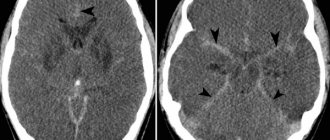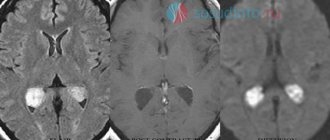For more than a hundred years, stage 4 brain cancer has been known as glioblastoma, anaplastic astrocytoma and other glial neoplasms. With the progression of the tumor focus in the cerebral ventricles and brain stem, the prevalence of the process, the prognosis is disappointing.
Life expectancy depends on the speed of spread of the oncological process, time of detection and localization. In inoperable conditions of the disease, stage 4 brain cancer, regardless of the location of the lesion, doctors’ actions are aimed at relieving pain, reducing swelling and intracranial pressure.
Stage 4 brain cancer is diagnosed if: • tumor dimensions are more than 30 mm; • metastases are present; • there is growth into intracranial vessels; • circulation of cerebrospinal fluid is impaired; • the neoplasm is located in the brain stem;
Brain tumor – what is it?
A tumor is a voluminous formation, which is a group of atypical cells that are rapidly increasing their population. A tumor in the brain can be either benign or malignant.
All neoplasms of the central nervous system are divided into primary and secondary:
- Primary - those that developed directly in the brain
- Secondary - are metastases of malignant neoplasms of a different location (lungs, kidneys, etc.)
There are a large number of different classifications of tumors of the nervous system. But the histological structure of the neoplasm and its location are of greatest clinical importance.
Based on location, primary tumors are divided into two large groups:
- Brain tumors – account for up to 90% of all central nervous system tumors
- Spinal cord tumors – 10% of central nervous system neoplasms
There are also oncopathologies localized simultaneously in the brain and spinal cord. But their share of the total number of tumors is insignificant - it is a fraction of a percent.
Neoplasms can also be of origin:
- Intracerebral - originate from brain cells
- Extracerebral - comes from blood vessels, nerve sheaths, fragments of embryonic tissue, pituitary gland
Malignant primary brain tumors of intracranial localization have a number of features that distinguish them from cancer of any other location:
- They practically do not metastasize. That is, they do not form daughter tumors in the lymph nodes and other organs.
- The central nervous system is separated from the rest of the body by the blood-brain barrier. Therefore, such tumors usually do not extend beyond the brain.
- Due to the high risk of damage to functionally important areas of the brain, most of these tumors are inoperable.
Due to the above reasons, the classification of tumors according to TNM (tumor size, regional and distant metastases) is practically not used in neuro-oncology. Stages are determined based on the histological type of tumor, and not the extent of the oncological process.
According to WHO, there are 10 histological types of tumors of the central nervous system:
- From neuroepithelial tissue
- From the meninges
- From the nerves
- From hematopoietic tissue
- Germinogenic - from germ cells
- Cysts and tumor formations
- Neoplasms growing into the cranial cavity
- Tumors of the sella turcica (this is a fragment of one of the bones of the skull in which the pituitary gland is located)
- Metastatic tumors
- Unclassified neoplasms
Diagnosis
Diagnosis in the early stages is possible if a person is regularly examined. Then you can quickly begin treatment. The disease can be diagnosed by a neurologist and neurologist.
At the first suspicion of glioblastoma, an anamnesis is collected and tests are taken for research.
Afterwards examinations are prescribed:
- CT: with it it is possible to obtain a good image of the necessary structures;
- MRI: structures of the central nervous system are visible in the image produced by an intense magnetic field;
- biopsy: biomaterial is taken for research;
- magnetic resonance spectroscopy: you can find out what the metabolism is in the brain;
- lumbar puncture: cerebrospinal fluid is taken;
- SPECT, PET: determination of functional tissue activity of the brain;
- electroencephalography: study of brain activity.
Gliomas
Gliomas are tumors of neuroepithelial tissue. They make up more than half of all tumors of the central nervous system. This type of brain tumor is most often the result of genetic mutations. These include glioblastomas, astrocytomas, and ependymomas. Some develop for a very long time - years. Others progress rapidly and lead to the death of the patient within a few months.
Gliomas have 4 degrees of malignancy. Typically, grade 1-2 tumors are called benign, grade 3-4 tumors are called malignant. The latter include glioblastoma and anaplastic astrocytoma, the most common neuroepithelial tumors of the central nervous system. They account for up to 80% of all neoplasms of this type.
Diagnostic features
Oncological diseases are most often detected at the second and third stages, when there is not only a pronounced clinical picture. At this time, the tumor can already be detected, although it is still small and has practically not begun to metastasize. If brain cancer is suspected, the patient undergoes an assessment of his neurological status during a consultation with a neurologist. The specialist pays attention to focal symptoms, trying to determine the approximate localization of the pathology. An examination by an ophthalmologist is equally important. It consists of testing visual acuity and ophthalmoscopy. In addition, using computer perimetry, the doctor determines the visual fields. Stage 2 brain oncology can be detected using instrumental diagnostic methods.
Echo-EG (echoencephalography), EEG (electroencephalography). The first registers expansion of the lateral ventricles, which indicates the development of intracranial hypertension. The middle M-echo will also be displaced - evidence of a neoplasm that has shifted the cerebral tissue. The second shows epiactivity in some areas of the brain.
CT (computed tomography). One of the leading diagnostic methods. It is resorted to in case of any suspicion of a space-occupying tumor in the brain. Computed tomography allows you to visualize it, determine its size, localization, and also differentiate it from edema. The images will show calcifications, necrosis, hemorrhage, and a cystic cavity, if present.
MRI (magnetic resonance imaging). Provides additional information to the data obtained during CT. It allows you to accurately determine the extent of the pathological process and the degree of involvement of surrounding tissues in it. MRI of cerebral vessels allows one to examine the vascularization of a neoplasm, as well as assess the condition of cerebral vessels, the nature of blood flow, and visualize arteries, veins and venous sinuses. Functional MRI is performed to map the language and motor areas of the brain.
MR spectroscopy. With its help, biochemical changes in tissue are determined and deviations in metabolic processes occurring in the cells of cerebral tissue are analyzed. The use of a contrast agent is not required.
MR thermography. Shows abnormal areas of hyperthermia associated with increased vascularity and indicating the presence of a neoplasm. Allows you to determine the location of the tumor, clarify its contours and structure.
PET-CT of the brain . Positron emission tomography helps evaluate metabolic processes, determine the degree of malignancy of the tumor and map functional areas.
SPECT. Single-photon emission computed tomography using radiopharmaceuticals that are sensitive to cerebral neoplasms makes it possible to identify small lesions, assess their malignancy and examine vascularization.
The final diagnosis is made on the basis of stereotactic biopsy of tissue samples from the lesion. Histological examination verifies the neoplasm and clarifies its level of differentiation, that is, it will allow one to assess the malignancy (aggressiveness) of the pathological process.
Tumors from the meninges
Neoplasms from the meninges account for about 20% of primary CNS tumors. 95% of cases of cancer of this type are meningiomas. The remaining 5% are fibrous histiocytomas, hemangiopericytomas, melanomas, diffuse sarcomatosis and others.
Some risk factors for tumors from the meninges have been established. Here's what can cause a brain tumor:
- Head injuries
- Ionizing radiation (including radiation therapy)
- Eating Nitrites
Genetic defects in chromosome 22 have been identified, due to which a brain tumor can develop. The cause is a mutation at the 22q12.3-qter locus.
According to malignancy, meningiomas are divided into 3 groups:
- Grade 1 - includes 9 histological types, the most common of which are meningoepithelial (60% of cases), transitional or mixed (25%) and fibrous (12%)
- Grade 2 – these are atypical meningiomas, which are marked by rapid cell division and rapid growth
- Grade 3 – anaplastic meningiomas (old name – meningosarcoma)
Rarely, multiple brain tumors occur. The reasons for their occurrence are not known. They make up about 2% of all diagnosed meningiomas. Such neoplasms are characterized by a favorable clinical course. In 90% of cases, a person lives a full life with them, without any symptoms. Only 10% of cases require surgical removal of tumors.
Send a request for treatment
Principles of classification of brain cancer
Several principles for grading tumors according to ICD 10 have been developed. The complexity of the problem requires a reconsideration of the problem. The latest WHO classification was created in 2007. It is better to distinguish neoplasms according to histological principles, which influence the duration of progression and prognosis:
- Metastatic – from secondary foci;
- Meningeal – meningioma;
- Neuroepithelial - astrocytoma, glioma, ependymoma - are formed from brain cells;
- Pituitary – adenoma;
- Transformation of cranial nerve roots – neuroma;
- Dysembryogenetic - formed during the embryonic development of the fetus.
According to the latest ICD 10 classification, about one hundred different types of brain cancer with histological confirmation are identified separately.
Pituitary tumors
Up to 10% of all intracranial neoplasms are pituitary tumors. They are almost always benign. They usually develop from cells of the adenohypophysis (the anterior lobe of this gland). Such neoplasms are called adenomas, and if they have a diameter of less than 1 cm - microadenomas. What causes a brain tumor of the corresponding localization has not yet been established.
Although some risk factors are known:
- Brain infections
- Traumatic brain injuries
- Toxin poisoning
- Use of oral contraceptives
- Obesity
The causes of a tumor in the brain that grows from pituitary gland cells may be due to gene mutation. Hereditary predisposition is of no small importance. At what age can a brain tumor of adenohypophyseal origin develop? This is one of the “youngest” tumors. It occurs in everyone, including children. The peak incidence occurs in working age - from 30 to 50 years.
Most pituitary adenomas are not accompanied by severe symptoms, so their detection rate is low. Treatment is usually carried out conservatively (normalizing the level of hormones in the blood). When it stops working, surgery is used.
First manifestations and symptoms
The first signs of breast cancer are not highly specific, but their appearance requires an unscheduled consultation with a doctor. Among these symptoms:
- Headache. This malaise is a typical cerebral sign of a progressive tumor.
- Movement disorders. The arm begins to bend poorly, the leg ceases to obey, and hypertonicity of some muscles appears.
- Nausea and vomiting. This general cerebral sign of brain cancer can appear outside of meals, including on an empty stomach. Sometimes a wave of uncontrollable gushing vomiting comes without preliminary nausea, suddenly and reflexively.
- Dizziness. The main reason for this symptom is increased intracranial pressure. The discomfort is complemented by tinnitus and hearing impairment.
- Mental signs. Patients note a feeling of stupefaction, attention weakens, and memory and perception are dulled. There may be a decrease in criticality, deterioration in associative thinking, lethargy and indifference.
The way brain cancer manifests itself also depends on the location of the tumor. Before signs of increased intracranial pressure appear, the patient often experiences an epileptic syndrome. Convulsive tonic-clonic seizures manifest themselves in brain cancer of different locations, but most often such symptoms are typical for damage to the frontal lobes.
Germ cell tumors
Germ cell tumors in the brain develop from embryonic tissue. These neoplasms include germinoma, choriocarcinoma, yolk sac tumor, and embryonal carcinoma. They are located in the area of the epiphysis. The most common is germinoma. It accounts for up to 0.5% of all brain tumors in representatives of the European race, and up to 3% in Asians. The reasons why this brain tumor occurs more often in the Asian population are not known. It is diagnosed more often in boys. The tumor is malignant - it metastasizes through the cerebrospinal fluid (the fluid that washes the brain).
Treatment after surgery
After surgical treatment for malignant neoplasms, radiation and chemotherapy are performed. They help reduce the risk of relapse and increase the patient's life expectancy.
After some time, the malignant tumor may reappear in the brain. In many patients, repeat surgery may be performed to remove it. Repeat surgery is generally less successful. However, many patients after such operations can live for several more years, while the lack of treatment would lead to death within a few weeks.
For treatment of malignant brain tumors, contact the NACFF clinic. Call or request a call back to get a consultation with an oncologist or neurosurgeon.
Send documents by email The possibility of treatment will be considered by the chief physician of the clinic Anton Aleksandrovich Ivanov, oncologist-surgeon, kmn
Metastatic brain tumors
About 20% of the structure of CNS neoplasms are metastatic brain tumors. The causes of these diseases are obvious: the spread of metastases from other parts of the body. It is believed that their actual prevalence is even higher. After all, cancer patients with stage 4 cancer are often not examined too carefully due to the inappropriateness of in-depth diagnostics. Even if there is a suspicion that they have a brain tumor due to cancer of another location, such patients are no longer referred to neurosurgeons.
What can cause such a brain tumor? Here are the most common reasons:
- Lung cancer – 40% of cases of metastatic damage to the central nervous system
- Breast cancer – 10%
- Kidney – 7%
- Stomach or intestines – 6%
- Melanomas - on average 5%
Types of brain oncology
One of the main criteria for the classification of malignant neoplasms is the cellular and tissue composition, that is, the cytological and histological structure of the tumor. There are many types of brain cancer, the main ones are:
- neuroepithelial ─ formed from cerebral tissue (glioblastoma, astrocytoma, ependymoma, neuroblastoma, medulloblastoma);
- neoplasms of the meninges (anaplastic meningioma, hemangiopericytoma, chondrosarcoma);
- choroid plexus tumors (choroid carcinoma);
- malignant formations of the pineal gland - pineal gland (pineoblastoma);
- neoplasms of the pituitary gland (adenocaricinoma).
There are many classifications based on tumor histology. Most specialists use the system developed by WHO experts.
What is cancer and why does it occur? October 30, 20202859 49
Tumors of childhood
Even children can get a brain tumor. Among childhood cancers, brain tumors account for about 20%. This is second only to leukemia. More often they are observed in children of the first year of life. Teratomas are found mainly in children. In older children, benign astrocytomas (more than 30%), primitive neuroectodermal tumors (medulloblastoma, pineoblastoma - 20%) and ependymomas (15% of cases among children over 1 year of age) predominate.
At present, it is not known for certain how brain tumors form in children. It has been established that they develop more often in boys than in girls. The reasons why brain tumors are more common in male children have not been established.
How can you get a brain tumor?
Patients often ask their doctor how they can get a brain tumor. They suggest that knowing the causes will help prevent the disease. Unfortunately, it is not. For many types of cancer, the underlying etiological factors have indeed been established. For example, it is well known that lung cancer occurs mainly due to smoking, cervical cancer is caused by human papillomavirus infection, and liver cancer is caused by viral hepatitis C. But what causes a brain tumor is still not known. Despite numerous clinical studies, scientists have not been able to establish the causes of brain tumors.
However, some risk factors have been identified:
Radiation . There are many ways you can get a brain tumor due to radiation. Most often this is radiation therapy for cancer or occupational hazards (radiologists, nuclear industry workers). In children, in the old days, the cause of brain tumors was radiotherapy used for fungal infections of the scalp.
The connection is not always clearly visible. After all, the first symptoms appear only 10-15 years after irradiation. But a retrospective analysis of medical records shows what can cause a brain tumor. Anamnesis data demonstrate that neoplasms of the central nervous system are more often observed among individuals exposed to radiation exposure.
Does this mean that a brain tumor occurs from radiography, fluorography or computed tomography? After all, these methods are based on the effects of ionizing radiation. No, no such connection has been established. Even decades ago, when the devices were much less advanced and gave tens of times more radiation load, there was no reason to believe that a brain tumor could occur as a result of the diagnostic procedures performed. Today, the devices used are so precise and perfect that the radiation is minimal, without damaging cells or causing mutations.
Heredity . Some genetic abnormalities have been identified that may cause a brain tumor. These include neurofibromatosis type 1, type 2, tuberous sclerosis, Hypeel-Lindau disease, Li-Fraumeni syndrome. There are other genetic causes of brain tumors, but they are much rarer.
Immunity . One of the types of neoplasms of intracranial localization is lymphoma. This brain tumor can occur due to decreased immunity. This is caused by AIDS, treatment after organ transplantation (immunosuppressive therapy), long-term use of immunosuppressants and glucocorticoids for dermatological diseases or systemic connective tissue lesions.
There are also several mythical reasons worth noting. Many people are afraid of them, but these fears are false.
So, here's what a brain tumor can't cause:
- Using a mobile phone – contrary to popular belief, it does not emit ionizing radiation
- Playing soccer (soccer players often head the ball)
- Exposure to electromagnetic fields
- Hair dye
- Stress and bad habits
We also note several controversial reasons why a brain tumor can occur. These risk factors are suspected but not yet definitively proven.
Among them:
- Aspartame (sweetener for diabetics)
- Exposure to vinyl chloride (occupational hazards in plastics production)
- Viral infections
- Exposure to petroleum products
Thus, scientists do not yet know exactly what causes a brain tumor. Therefore, the only thing you can do to prevent this disease is not to expose yourself to massive ionizing radiation and, if possible, maintain a good immune system.
Causes
The impossibility of identifying the etiological factor excludes the possibility of conservative treatment of a tumor of any stage.
The main theories of the occurrence of brain tumors:
- Genetic determination. Oncologists claim the presence of a genetic predisposition to cancer. Every person has genes that cause cancer. The start time of the activity of the genetic material, localization, intensity of the process - individual characteristics;
- Viral activity provokes DNA changes. A change in the genetic component determines the likelihood of developing an oncological process. The etiological role of papillomavirus in the occurrence of cervical cancer has been proven. Research into infectious agents of intracerebral tumors is ongoing;
- Chemical - supporters of the theory consider cerebral cancers to be a consequence of the action of certain types of chemicals. Taking pharmaceutical drugs with a toxic effect on brain cells, intoxication during illnesses can cause oncological conditions;
- Physical – the occurrence of cancer as a result of exposure to radiation, X-rays, and other types of ionizing radiation.
Literary sources describe other causes of oncology. Until the real causes are identified, it is impossible to treat neoplasms using conservative methods.
Meningeal brain tumor - prognosis
The survival rate for meningiomas is high. The clinical course of the disease is favorable. Usually these are neoplasms of 1st degree of malignancy. If there are no symptoms of pathology, an observation strategy is used. Surgery may not be necessary because most of these brain tumors have a good prognosis.
The first thing patients are interested in is how long do they live with a brain tumor of meningeal origin? This depends on a number of factors. First of all, it depends on the degree of malignancy, as well as the treatment performed.
If the brain tumor was completely removed during surgery, how long people live depends solely on their age and health status, because meningioma does not recur with a 95% probability. Only 5% of patients experience recurrences within 15 years after surgery.
But sometimes the neoplasm is localized in functionally active structures of the central nervous system. In such cases, complete removal is not possible. However, even if it was partially removed, the risk of recurrence within 15 years is only 50%. In the remaining 50% of cases, the tumor remains the same size - it does not grow. If growth of meningioma is observed, it responds well to treatment with radiation therapy. Even for malignant meningioma, radiation helps control tumor growth for at least 5 years.
The age of the patient is also important. Below you can see data on how long people live with a meningeal brain tumor, depending on age.
The percentage of five-year survival is indicated - that is, the number of people who will live for 5 or more years after diagnosis:
- Up to 45 years – 87%
- Up to 55 years – 77%
- From 55 to 65 years – 71%
In most cases, after 5 years the tumor no longer recurs if it was completely removed during surgery.
Diagnostics
Symptoms of the disease vary, and a patient with a larger tumor may experience less severe symptoms than a patient with a small tumor. The first thing the patient should do is visit a local physician, who will prescribe further tests.
An ophthalmologist can identify the disease by the condition of the eyeball.
When a patient consults a doctor with symptoms of the disease, he is prescribed:
- neurological examination;
- positive emission tomography;
- CT;
- MRI;
- angiography and other radioisotope techniques;
- magnetoencephalography;
- surgical intervention;
- stereotactic biopsy;
- venticuloscopy;
- Lumbar puncture.
Headaches due to brain tumor
Only after carrying out all the necessary studies can the doctor draw conclusions about the patient’s health status, determine the stages and possibilities of treatment.
Neuroepithelial brain tumor – how long to live?
If you have been diagnosed with a neuroepithelial brain tumor, how long to live cannot be definitely said without establishing its histological type. It is the structure of the neoplasm that determines how long a brain tumor takes to develop.
Based on this parameter, there are 4 degrees of malignancy of neuroepithelial neoplasms of the central nervous system:
- Grade 1 – pilocytic astrocytoma
- Grade 2 – protoplasmic, pleomorphic, hemistotic, fibrillary astrocytoma, xanthoastrocytoma and ependymoma
- Grade 3 – anaplastic astrocytoma
- Grade 4 – glioblastoma
Grade 1 and 2 neuroepithelial brain tumors are considered low grade. They have a more favorable prognosis. Grades 3 and 4 are neoplasms of high malignancy or simply malignant. The worst prognosis is characterized by a grade 4 brain tumor.
How long do people live with glioblastoma ? Unfortunately, this tumor has a worse prognosis. It develops very quickly and is manifested by necrosis (death) of parts of the brain. From the moment the tumor appears to the first symptoms, sometimes not even months, but weeks pass. The average life expectancy for patients under 40 years of age is no more than one and a half years, and for patients over 40 years of age – less than 1 year.
Five-year survival rate in developed countries, depending on age:
- Up to 45 years old – 19%
- From 45 to 55 years – 8%
- From 55 to 65 years – 5%
Patients do not even always undergo surgery, since they die from a grade 4 brain tumor quite quickly. Often only radiation and chemotherapy are used. But these methods do not significantly prolong the patient’s life. Unfortunately, glioblastoma is the most common glioma (neuroectodermal tumor). It makes up about 50% of the structure of these neoplasms.
Anaplastic astrocytoma is another malignant brain tumor. How long do people live with this disease?
Average life expectancy, depending on the patient’s age at the time of diagnosis:
- Up to 40 years – about 3 years
- From 40 to 60 years – on average 2 years
- After 60 years – less than 1 year
Five-year survival rate, depending on age:
- Up to 45 years old – 54%
- From 45 to 55 years – 32%
- From 55 to 65 years old – 14%
The pathology is characterized by infiltrative growth. That is, the tumor penetrates the brain tissue, rather than displacing it. Anaplastic astrocytoma is the second most common neuroectodermal tumor after glioblastoma. In the structure of these neoplasms it makes up about 30%.
The next most common tumor of the central nervous system from neuroectodermal tissue is oligodendroglioma . It accounts for about 5% of all gliomas. The average life expectancy of patients in developing countries, including the CIS, is 6 years. In developed countries (Germany, USA) the indicators are much better.
The five-year survival rate, depending on the age of the patient at the time of diagnosis, is:
- Up to 45 years – 88%
- From 45 to 55 years – 81%
- From 55 to 65 years – 68%
Unfortunately, sometimes oligodendroglioma becomes malignant. In this case, it acquires grade 3 malignancy, and the prognosis worsens. It is not known for certain what causes the brain tumor anaplastic oligodendroglioma. However, the life expectancy of patients is reduced.
Five-year survival rates for this type of neoplasm in developed countries:
- Up to 45 years – 71%
- From 45 to 55 years – 61%
- From 55 to 65 years – 46%
Ependymomas make up about 3% of gliomas. They are more common in children than in adults. Most often these are benign tumors. Anaplastic ependymomas (grade 3 malignancy) are rare. There is no data on what causes this brain tumor in children. Survival rates vary significantly between countries. In the CIS, the five-year survival rate for children over 3 years of age is about 50%, for adults – 70%. In developed countries, the statistics are much better due to better treatment.
Five-year survival rate for patients with ependymoma in countries with well-developed medicine:
- Children's age – 75%
- Patients from 20 to 45 years old – 92%
- From 45 to 55 years – 89%
- From 55 to 65 years – 86%.
How long do they live with a brain tumor from fetal tissue?
Germ cell tumors are malignant. They occur in children. They are characterized by metastases. The most common tumor is germinoma. It is also the most favorable. In the vast majority of patients, even without the use of surgical methods, this malignant brain tumor is cured. How long do they live after treatment? Life expectancy is potentially the same as that of a person who has never suffered from this pathology. To cure the disease, radiation therapy and sometimes chemotherapy (in children under 4 years of age) are sufficient. The younger the age, the better the prognosis. Unfortunately, the prognosis for other types of germ cell tumors is much worse. They are very rare. But patient survival is extremely low. These are inoperable brain tumors. How long do patients live? Only 5% of patients will live more than 2 years after diagnosis. Radiation therapy and chemotherapy are used for treatment, since surgical treatment does not improve the prognosis. Only palliative operations are performed. For example, shunting surgical interventions for blockage of the cerebral aqueduct.
Metastatic brain tumor – how long to live?
In many cases, cancer is detected after metastases have appeared in the central nervous system. How long people live with a metastatic brain tumor depends on the treatment provided. In the natural course of the disease, the average life expectancy of patients is about 3 months. With surgical treatment or radiation therapy, it can reach 2 years or more. Life expectancy also depends on the histological type of cancer, location and number of metastases. In approximately 50% of cases they are multiple, which worsens the prognosis.
Send a request for treatment
Where to go if you have brain cancer?
The diagnosis and treatment of brain cancer and astrocytoma are the most successful in Germany and other developed countries, which is confirmed by patient survival statistics. If you want to use the services of German doctors, please contact ]Booking Health[/anchor]. We organize treatment abroad.
Our advantages:
- A team of doctors who understand modern methods of treating various diseases will select the best clinic for the treatment of brain cancer for you.
- Thanks to direct contracts with the best medical institutions in Germany, you can save up to 70% of the cost of the treatment program. In addition, the waiting time for a doctor’s appointment will be reduced.
- The initially agreed cost of treatment is guaranteed not to change. Even if complications arise and additional therapeutic measures are required, all unforeseen expenses will be covered by insurance.
- A full package of services: we will completely organize the entire treatment process in Germany, provide an interpreter, and provide transfer from the airport to the clinic.
- Absolute transparency of financial relationships: you can always find out what services you paid for and in what volume. Unused funds after treatment will be returned.
To take advantage of all the benefits of German medicine, leave a request on our website. After processing it, we will contact you and you will be able to receive comprehensive advice on the treatment of brain cancer abroad.
Possible treatment
The choice of treatment method depends on the type of tumor, its location and size. Doctors analyze the stage of the disease, the patient’s condition and the presence/absence of metastases, conduct tests and diagnostic procedures.
The optimal treatment option is complete removal of cancer cells. Advances in neurosurgery make it possible to perform low-traumatic and highly effective interventions on the brain. But the problem is that removing cancer tissue can be very difficult. GM neoplasms are prone to diffuse growth, they spread to nearby structures and tissues. For imaging, doctors use modern optical medical equipment and contrast agents.
Treatment may also include:
- radiation therapy;
- chemotherapy;
- brachytherapy;
- stereotactic radiosurgery.
Patients are required to be prescribed medications that can reduce symptoms of brain cancer and support the body. Inoperable cancer requires palliative supportive treatment.










